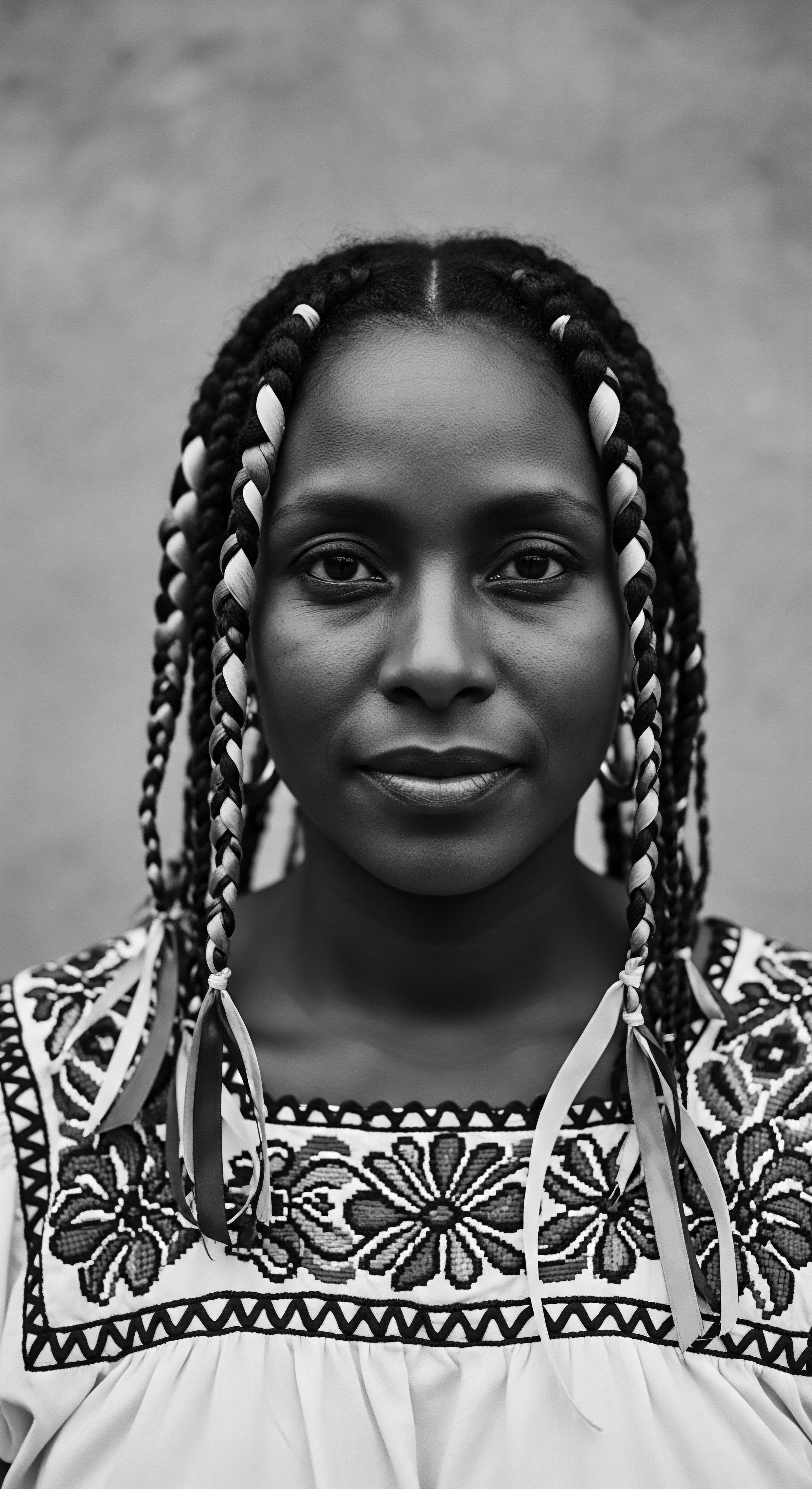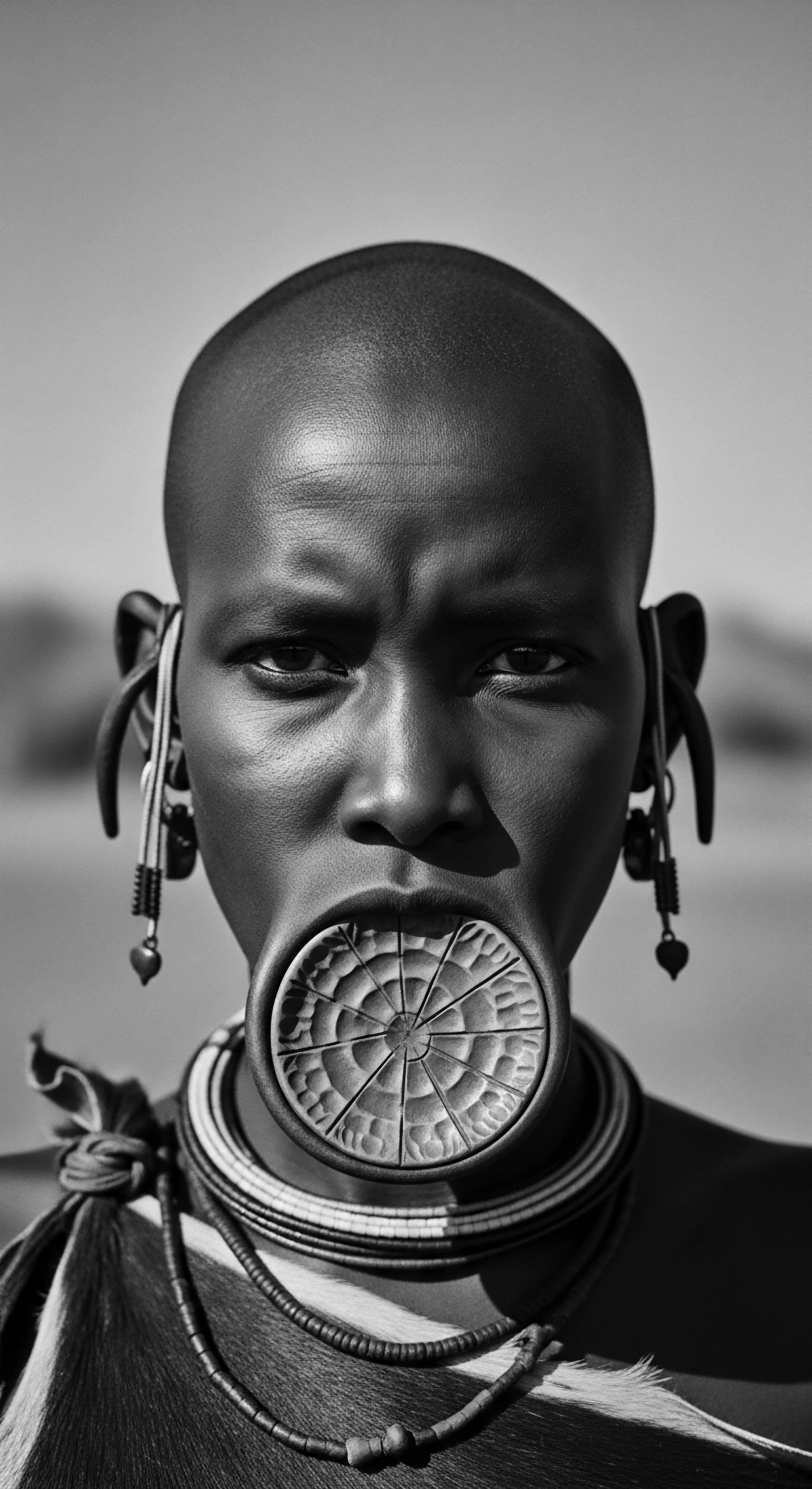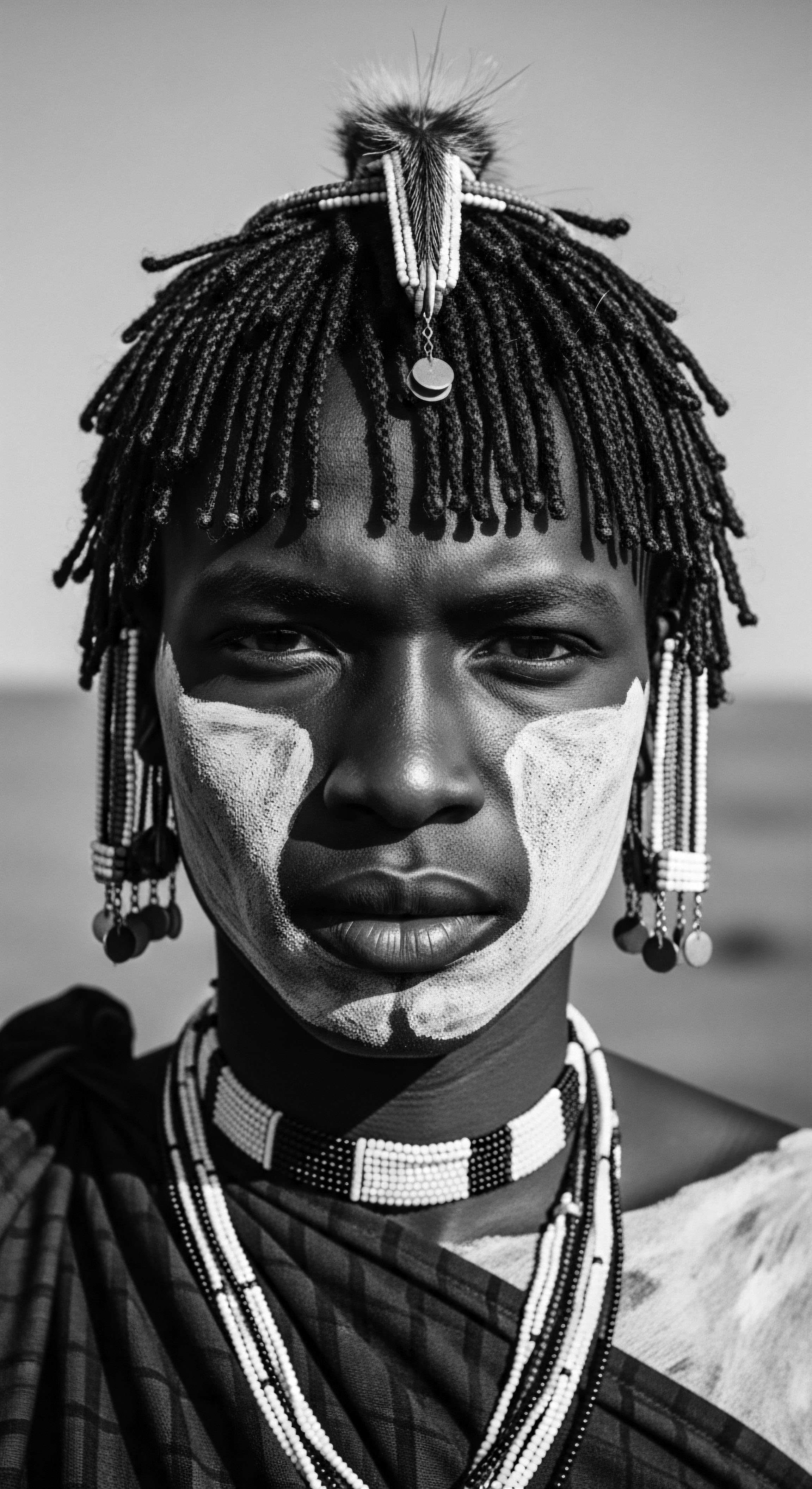
Fundamentals
The venerable Bixa Orellana, often known by its evocative names such as Annatto, Achiote, or Urucum, presents itself as far more than a mere botanical specimen; it embodies a profound ancestral legacy, particularly within the vast tapestry of textured hair heritage. This tropical shrub, or at times, a small tree, hails from the verdant expanses of Central and South America. Its true renown stems from the remarkably vibrant pigment derived from the seeds, nestled within distinctive heart-shaped, spiny capsules. These seeds, when processed, yield an orange-red to reddish-yellow color, widely recognized as annatto.
Consider its immediate visual impact ❉ the mature fruit pods, which ripen to a striking reddish-brown, eventually burst open, revealing an abundance of small, crimson-hued seeds. Each seed is encased in a waxy aril, a thin coating that holds the potent color. This rich coloration, a gift from the earth, has long served humanity, transcending simple utility to become a conduit for cultural expression and deep-rooted practices. The common designation “lipstick tree” provides an early hint of its longstanding cosmetic uses, hinting at centuries of adornment and self-expression before modern formulations existed.
Historically, communities revered the Bixa Orellana plant for its profound ability to bestow color. This elementary understanding of its essence formed the bedrock for a myriad of applications, ranging from ceremonial body paint to the dyeing of textiles and foodstuffs. Even at this foundational level, its capacity to impart color was not merely a functional attribute; it was imbued with cultural significance, allowing for visual communication and the perpetuation of aesthetic traditions across generations.

Intermediate
Moving beyond the initial grasp of Bixa Orellana as a simple source of color, we begin to appreciate its intermediate layers of meaning, revealing how its elemental properties became woven into the daily lives and spiritual worldviews of ancestral communities. The journey of Bixa Orellana is not merely geographical; it traces the evolution of human ingenuity and cultural adaptation, particularly within the sphere of personal adornment and wellbeing.
The rich, earthy pigments extracted from the seeds, primarily through crushing and mixing with water or oils, were not confined to the superficial. They were understood as a dynamic force, capable of transforming and protecting. Indigenous peoples, particularly across its native Americas, employed the plant in multifaceted ways, demonstrating a sophisticated understanding of its benefits.
For instance, the carotenoids present in annatto, notably bixin and norbixin, offered natural protection from harsh sunlight and acted as an insect repellent, attributes that were invaluable in tropical environments. This protective quality extended beyond the physical realm, as certain indigenous groups, such as the Tsáchila, would paint their bodies, faces, and hair with the pigment, believing it would ward off evil spirits.
Its practical and symbolic utility propelled Bixa Orellana far beyond its Amazonian origins. Through complex pre-Columbian trade networks and, later, the expansive reach of colonial exchanges, its seeds traveled across continents. The dye, and by extension, the plant itself, found new homes and new interpretations in Southeast Asia, various parts of Africa, and across the Caribbean.
This global distribution speaks to the plant’s inherent value and the universal human desire for color and natural solutions. The tradition of natural dyeing, relying on the deep wisdom of plant knowledge, continued in many regions, often through intricate processes passed down orally.
Bixa Orellana transcended its biological origins, becoming a potent symbol of protection and cultural identity across diverse ancestral communities.
In these new landscapes, Bixa Orellana became intertwined with existing local practices, demonstrating the adaptability of ancestral knowledge. While its most prominent use might be culinary in many Caribbean and Latin American cuisines, where it imparts a warm, inviting hue and a subtle, earthy flavor to dishes, its cosmetic and protective applications persisted. The plant’s significance was thus layered ❉ it was a food additive, a medicine, a cosmetic, and a spiritual aid, all at once. This holistic perspective, where various elements of daily life were interconnected, lies at the heart of ancestral wisdom.
- Cosmetic and Protective Applications ❉
- Natural Sun Protection ❉ The carotenoids within the seeds provided indigenous communities with a natural barrier against the intense tropical sun.
- Insect Repellent ❉ Its qualities helped deter insects, an essential function in environments teeming with life.
- Skin and Hair Adornment ❉ Beyond aesthetic appeal, the application of annatto to skin and hair held ceremonial and protective significance, often believed to safeguard individuals from malevolent entities.
- Global Dissemination and Adaptation ❉
- Pre-Columbian Networks ❉ The plant’s movement beyond its initial growing regions highlights sophisticated ancient trade routes within the Americas.
- Colonial Introductions ❉ European exploration facilitated its spread to other tropical regions, including Africa and Asia, where it became naturalized and integrated into local economies and customs.
- Culinary Integration ❉ Its role as a food coloring and flavor agent became widespread in Latin American, Caribbean, and Filipino cuisines, frequently serving as a cost-effective alternative to saffron.
The persistent use of Bixa Orellana across such diverse applications underscores its foundational role in human well-being and cultural expression throughout centuries. Its presence in varied societies, from indigenous communities maintaining ancient rituals to its adoption in global culinary traditions, serves as a testament to its inherent value and widespread utility.

Academic
The academic understanding of Bixa Orellana extends beyond its functional attributes to critically examine its profound meaning as a cultural artifact, a biological marvel, and a historical witness, particularly within the interwoven narratives of textured hair heritage. Its scientific classification as Bixa orellana L., within the family Bixaceae, belies a complex history rooted in indigenous knowledge systems, diasporic adaptations, and the persistent quest for natural forms of care and self-expression. The plant, often referred to as the ‘seed of fire’ or ‘seed that shines’ in Nahuatl, speaks to its luminous qualities and its spiritual resonance in ancient cosmologies. Its very essence is intertwined with the sun, life, and the vibrant hues of existence.

Ancestral Pigment and Textured Identity ❉ Echoes from the Source
At its core, Bixa Orellana is a repository of carotenoid pigments, predominantly Bixin and Norbixin, which contribute to its striking red-orange color. These compounds are not merely coloring agents; they are potent antioxidants and possess anti-inflammatory properties, qualities that were intuitively recognized and harnessed by ancestral communities for myriad purposes, including applications to skin and hair. For the ancient peoples of Central and South America, the preparation of annatto from the seed’s aril was a meticulous process, transforming raw botanical material into a vital resource for health, aesthetics, and ritual.
The connection between Bixa Orellana and hair heritage is perhaps most vividly articulated through the enduring traditions of indigenous peoples. A compelling historical example is found in the Tsáchila tribe of Ecuador. This community has maintained a distinctive practice of dyeing their hair a bright, rich orange using crushed annatto seeds, a tradition that extends back centuries. This is not a fleeting cosmetic choice; it is a powerful visual marker of ethnic identity, cultural continuity, and spiritual connection.
The Tsáchila’s practice signifies a deliberate choice to carry forward ancestral knowledge in the face of external pressures, their vibrant hair serving as a living testament to their heritage. This centuries-old adherence to annatto hair dye within the Tsáchila community, documented as a symbol of identity, stands as a poignant illustration of Bixa Orellana’s deep cultural significance in the sphere of textured hair. This practice is not solely about aesthetics; it embodies a philosophical stance, a commitment to a way of life where external appearance is deeply linked to internal identity and ancestral memory.
The movement of Bixa Orellana beyond its native domains, particularly during the trans-Atlantic exchanges, meant that it became accessible in regions with significant Black and mixed-race populations, such as the Caribbean and West Africa. While direct historical documentation of Bixa Orellana’s use specifically for hair dyeing within these diasporic Black and mixed-race communities for cosmetic purposes is less prominent compared to indigenous practices, its widespread use as a body paint, cosmetic, and traditional medicine suggests a broader ancestral understanding of its properties for skin and hair health. The principles of utilizing natural botanicals for healing and adornment were, indeed, deeply ingrained in various African traditional practices long before colonial encounters. The rich historical context of Black hair, often serving as a profound marker of identity, status, and communication in pre-colonial African societies, underscores the potential for new natural ingredients, like Bixa Orellana, to be integrated into existing or evolving hair care rituals.
The Tsáchila tribe’s enduring centuries-old practice of annatto hair dyeing vividly illustrates Bixa Orellana’s role in preserving cultural identity and ancestral knowledge.
The inherent properties of the plant, such as its insect-repellent qualities and its ability to offer some protection from solar radiation, would have been recognized as beneficial for overall scalp and hair health in tropical climates. The inclusion of Bixa Orellana in traditional healing repertoires for various skin conditions also points to an understanding of its potential benefits for the scalp, the foundation of healthy hair.
| Community/Region Tsáchila Tribe (Ecuador) |
| Primary Application Traditional hair dye (bright orange) as a core identity marker. |
| Community/Region Amazonian Tribes (Brazil) |
| Primary Application Body and face paint, sometimes extended to hair, for ceremonial or protective purposes. |
| Community/Region Tainos (Puerto Rico) |
| Primary Application Body and hair paint for cultural and spiritual expression. |
| Community/Region West Africa / Guyana / New Guinea |
| Primary Application Body decoration mixed with oils, also believed to repel insects and protect against sunburn. |
| Community/Region The consistent use of Bixa Orellana across diverse cultures underscores a shared ancestral appreciation for its protective and symbolic attributes. |

The Unbound Helix ❉ Bixa Orellana in Contemporary Heritage Care
The resurgence of interest in natural ingredients within the contemporary hair care landscape for textured hair represents a cyclical return to ancestral wisdom, a reclamation of knowledge that was often marginalized or dismissed during periods of colonial influence and the proliferation of synthetic alternatives. The current scientific understanding of Bixa Orellana validates many of the empirical observations made by historical practitioners. For example, the presence of bixin and norbixin as powerful antioxidants holds significance for hair health by combating oxidative stress that can damage hair follicles and strands. Oxidative stress can contribute to issues like hair thinning and a general decline in hair vitality, issues that resonate deeply within the textured hair community that often seeks robust solutions for maintaining hair integrity and growth.
The application of Bixa Orellana derivatives in modern formulations, often as a natural coloring agent in cosmetics, presents an opportunity to bridge ancient practices with contemporary needs. This convergence is not merely about aesthetic appeal; it signifies a conscious choice to align with traditional practices, to honor the historical significance of plant-based care. The gentle wisdom conveyed by natural ingredients speaks to a desire for products that nourish, rather than merely alter, the inherent nature of textured hair. This re-evaluation of natural dyes and botanicals like Bixa Orellana reflects a movement towards ethical and sustainable beauty, one that considers the provenance of ingredients and their historical lineage.
Modern scientific inquiry often validates the deep wisdom embedded in ancestral practices, illuminating Bixa Orellana’s protective and health-promoting compounds.
Moreover, the conversation around Bixa Orellana within the context of Black and mixed-race hair experiences extends beyond its chemical properties to the profound cultural dialogues it facilitates. The ongoing exploration of ancestral hair practices, including the use of plants for adornment and care, becomes a medium for reconnecting with historical identity and resilience. Textured hair, with its unique structural characteristics, has historically been a site of both profound beauty and societal struggle. The journey of hair from a source of pride in pre-colonial African societies, symbolizing status and communication, to a target of discrimination in post-colonial contexts, underscores the deep cultural and political dimensions of Black hair.
The integration of ingredients like Bixa Orellana into contemporary textured hair care is more than a trend; it represents a reclamation of autonomy and a celebration of indigenous and ancestral knowledge. It is a quiet assertion that the earth provides, and that long-held wisdom offers pathways to authentic care and self-expression. The ability of Bixa Orellana to impart color, its protective qualities, and its symbolic ties to vitality and the earth make it a compelling subject for those seeking to ground their hair care rituals in a rich historical and cultural understanding.
The careful selection of ingredients, such as those derived from Bixa Orellana, speaks to a desire for authenticity and a connection to something larger than oneself. It represents a conscious decision to move away from overly processed, synthetic products towards formulations that honor the intricate beauty of textured hair and its deep heritage. This approach allows individuals to engage with their hair not merely as a biological entity but as a living extension of their ancestral story.
The ongoing research into the bioactive compounds of Bixa Orellana, like its antioxidant and anti-inflammatory activities, continues to provide a scientific foundation for its traditional uses, offering a testament to the empirical knowledge accumulated over millennia. This validation allows for a richer, more informed appreciation of how ancestral wisdom and modern scientific inquiry can converge, creating a more comprehensive understanding of plants like Bixa Orellana and their enduring relevance to textured hair care.
- Reclamation of Natural Modalities ❉
- Historical Validation ❉ Modern scientific investigations often affirm the empirical wisdom of ancestral communities regarding the therapeutic and cosmetic attributes of Bixa Orellana.
- Conscious Ingredient Choice ❉ The growing preference for natural ingredients like Bixa Orellana in hair care products signifies a deliberate shift towards authenticity and a reverence for traditional knowledge.
- Hair as a Cultural Repository ❉
- Symbol of Identity ❉ Textured hair has consistently served as a profound symbol of cultural heritage, resilience, and personal expression across Black and mixed-race communities globally.
- Bridging Eras ❉ The utilization of Bixa Orellana allows for a tangible link between contemporary hair care practices and the ancient traditions of adornment and protection, fostering a deeper connection to ancestral roots.

Reflection on the Heritage of Bixa Orellana
The journey through the nuanced layers of Bixa Orellana’s meaning leaves us with a deeper appreciation for its enduring legacy. From the primordial rainforests where its vibrant seeds first offered their crimson gift, to the intricate traditions of indigenous peoples who sculpted identity with its hues, and finally, to its resonance within the expansive realm of textured hair heritage today, Bixa Orellana stands as a quiet yet powerful testament to ancestral wisdom. It is a reminder that beauty, care, and well-being have always been profoundly connected to the earth’s offerings.
The whispers of those who first crushed its seeds, painting tales on skin and hair, still echo through time. Their practices, born of intimate observation and deep respect for the natural world, laid the groundwork for understandings now affirmed by contemporary scientific inquiry. Bixa Orellana invites us to consider hair not merely as biological strands but as living threads imbued with history, memory, and cultural significance. For those navigating the complexities of textured hair, this botanical ally offers more than physical conditioning; it offers a connection to a lineage of care, a sense of belonging to a continuous narrative of self-expression and resilience.
As we move forward, the spirit of Bixa Orellana compels us to seek authenticity in our choices, to honor the knowledge passed down through generations, and to recognize the sacred bond between humanity and the earth. The vibrancy it brings to hair, whether subtle or bold, becomes a conscious declaration of identity, a celebration of heritage, and a gentle act of tending to the self, truly embodying the Soul of a Strand. Its story continues to be written, each application a new verse in an ancient, ongoing poem of ancestral care.

References
- Survival International. Annatto ❉ from Amazonian body paint to popcorn.
- The Rs Farm. Annatto ❉ The Vibrant Lipstick Tree at The Rs Farm. 2024.
- WebMD. Annatto ❉ Seeds, Extract, Powder, and Oil. 2024.
- Galarza-Romero, L. et al. Study of Essential Oil Isolated from Achiote (Bixa orellana) Leaves ❉ Chemical Composition, Enantiomeric Distribution and Antimicrobial, Antioxidant and Anticholinesterase Activities. Molecules, 2023.
- Bynoe, H. Roucou, powerful Indigenous skin medicine. 2024.
- Sacred Earth. Annatto (Bixa orellana) – Gardening Jobs in March. 2019.
- Fées en Provence. Certified organic annatto or achiote. 2020.
- Wikipedia. Bixa orellana.
- Delamazonas.com. Achiote, onoto, annato, urucú, bija (Bixa orellana) ❉ the Seed of Fire. 2020.
- Venugopalan, A. et al. Food, ethanobotanical and diversified applications of Bixa orellana L. ❉ a scope for its improvement through biotechnological mediation. ResearchGate, 2011.
- Jaddstudio. Dyeing Using Philippine Indigenous Plants (Natural Dyeing). 2016.
- ArcGIS StoryMaps. Bixa orellana. 2023.
- Manaois, A. R. & Camara, J. S. Formulation and Evaluation of Hair dye from Atsuete (Bixa orellana L.) Seeds and Alugbati (Basella alba L.) Stem. PARESSU, 2018.
- Rojas, B. et al. Traditional Uses, Chemical Constituents, and Biological Activities of Bixa orellana L. ❉ A Review. Molecules, 2020.
- Spiritual Botany. The Lipstick Tree. 2020.
- Ross Organic. HEALTH PERSONAL CARE.
- Google Arts & Culture. Achiote.
- Specialty Produce. Annatto Seeds Information and Facts.
- Wikipedia. Annatto.
- Cargo Handbook. Annatto.
- PROTA4U. Bixa orellana.
- Moreira, L. L. et al. The Domestication of Annatto (Bixa orellana) from Bixa urucurana in Amazonia. ResearchGate, 2015.
- JSTOR Global Plants. Bixa orellana Linn. .
- Cruz, D. Ancestral Achiote. The William & Lynda Steere Herbarium – New York Botanical Garden, 2023.
- The Queen’s Journal. History, identity, and community ❉ The significance of Black hair. 2025.
- NMAAHC. Strands of Inspiration ❉ Exploring Black Identities through Hair. 2023.
